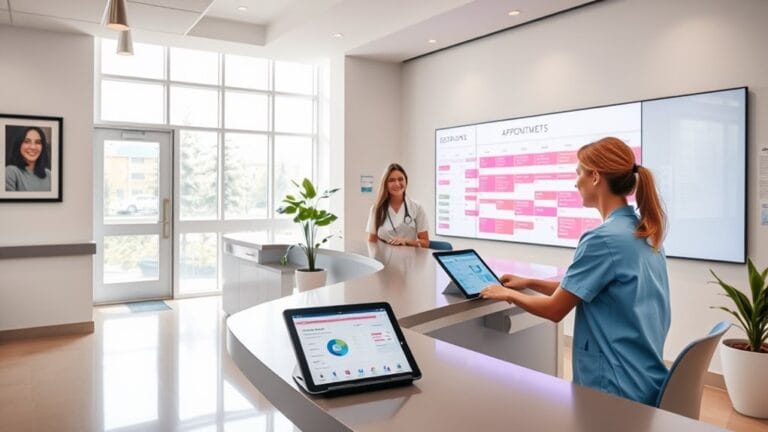Streamline Dental Workflows: 7 Efficient Automation Tips
You can enhance appointment scheduling, automate patient intake, and improve communication to create a smoother dental practice. By adopting efficient automation tips, you'll not only save time but also elevate patient satisfaction. However, the journey doesn't end there; there are additional strategies that can transform your workflow even further. Curious about the specific steps you can take to optimize your operations and guarantee a seamless experience for both staff and patients? If you need assistance, feel free to contact us—we can connect you with experts who can provide tailored solutions for your dental practice.
Optimize Appointment Scheduling
Optimizing appointment scheduling is essential for enhancing the efficiency of your dental practice and improving patient satisfaction. Implementing an online booking system allows patients to schedule appointments 24/7 from any device, aligning with their preferences and freeing up your front desk staff for other important tasks.
With over a third of appointments booked outside regular office hours, this feature can greatly enhance patient access.
Utilizing patient scheduling software transforms how you manage appointments. By integrating automated appointment reminders—whether through email, SMS, or phone calls—you can greatly reduce no-shows and missed appointments. This not only keeps patients informed but also bolsters adherence to treatment plans.
Real-time syncing with your practice management software guarantees your schedule is always accurate, preventing double bookings and appointment conflicts. By allowing patients to see available slots instantly, you empower them to choose times that suit their needs. Additionally, this system helps identify and fill empty appointments, maximizing your revenue while maintaining HIPAA compliance for patient data security. Implementing an online booking system with integration capabilities further streamlines your scheduling process by seamlessly connecting with existing software, ensuring efficient data management. Streamlining your scheduling process with these tools ultimately leads to increased patient satisfaction and operational efficiency.
Automate Patient Intake
Streamlining patient intake can greatly enhance the efficiency of your dental practice. By implementing digital forms, you can collect patient information quickly, reducing the need for physical paperwork and minimizing wait times. Patients can fill out forms from their devices, improving convenience and engagement. This no-touch solution not only speeds up the onboarding process but also aligns with COVID-19 reduction protocols.
Automatic updates to patient records eliminate manual re-entry, enhancing data accuracy and reducing errors. Verify that your digital forms are HIPAA-compliant to maintain digital security and keep patient data safe. By automating data entry and integrating with practice management software, you can further streamline workflows, guaranteeing that information is synced seamlessly across systems. This approach also ensures your practice is prepared for crises or economic uncertainties, enhancing overall resilience.
Providing a guided process for patients to complete their forms can greatly improve completion rates while reducing confusion. An omnichannel experience allows patients to interact with your practice through various digital channels, increasing satisfaction.
Ultimately, automating patient intake fosters a more efficient, secure, and patient-focused practice that prioritizes engagement and care.
Enhance Patient Communication
Enhance Patient Communication
After successfully automating patient intake, the next step is to enhance patient communication. By implementing effective patient engagement strategies, you can create a seamless communication experience tailored to your patients' preferences.
Utilize multi-channel communication, allowing patients to receive messages via SMS, email, or mobile apps—whichever they prefer. This flexibility not only boosts engagement but also fosters trust. Additionally, two-way texting enables communication anytime, enhancing office efficiency.
Automate appointment reminders and notifications, customizing them to fit your practice's needs. This will help reduce no-shows and fill last-minute openings. Consider integrating these reminders with your online scheduling software for easy appointment confirmations.
Personalized messaging is crucial. Create customizable templates with placeholders for efficient communication and include essential information like payment links.
Centralize your communication by setting up a hub that integrates all channels. This guarantees secure access and allows for after-hours responses, enhancing patient satisfaction. Don't forget to log all communication details for clear visibility.
Streamline Inventory Management
Effective inventory management is vital for maintaining a well-functioning dental practice. By utilizing UDI barcode scanning, you can swiftly capture product information, guaranteeing accuracy in your inventory categorization. Centralizing your inventory tracking in a cloud-based system allows you to access real-time insights from anywhere, making it easier to manage stock levels and receive automatic alerts for expiration dates and low inventory. Additionally, this system facilitates elimination of manual records, which significantly reduces errors associated with traditional record-keeping.
Simplifying the reordering process is equally important. With just a few clicks, you can initiate orders directly from your system, benefiting from instant visibility into stock levels. Implementing a disciplined approval process for generating orders guarantees accuracy and conserves staff time. You can also evaluate supplier prices in real-time, empowering you to negotiate better terms with multiple suppliers.
Improve Data Accuracy
Maintaining an organized inventory is just one piece of the puzzle; accurate data is equally important in a dental practice. By improving data accuracy, you enhance patient care and streamline operations.
Implementing AI diagnostics can greatly reduce human error in radiograph interpretation, enabling precise identification of dental issues. AI algorithms analyze x-rays pixel by pixel, spotting anomalies and evaluating conditions with greater sensitivity and specificity. This technology aids in the reliable identification of dental caries presence and severity, making it an invaluable asset for dental practices.
To further bolster data accuracy, consider these strategies:
- Utilize electronic data capture (EDC) systems to minimize manual entry errors.
- Implement automated data validation for real-time accuracy checks.
- Consolidate provider data management on a single platform to maintain current information.
- Adhere to best practices in dental imaging for accurate diagnoses.
- Invest in regular training to keep your skills sharp in reading radiographs.
Simplify Financial Processes
Streamlining financial processes is essential for enhancing the overall efficiency of your dental practice. By automating accounts payable, you can greatly reduce human error and improve accuracy. Implement Optical Character Recognition (OCR) to read and log invoice data, minimizing manual entry, and centralize your AP processes to streamline operations across multiple locations. This not only reduces discrepancies but also automatically flags potential duplicate payments, preventing costly mistakes. Implementing AP automation can enhance visibility through built-in reporting tools, allowing you to track vital AP metrics.
Focusing on your revenue cycle is equally important. Automate eligibility verification to instantly check patient insurance coverage, which helps reduce claim rejections. Utilizing automated claim submission and payment posting accelerates reimbursement timelines and guarantees accurate financial reporting.
Implement electronic payment options to speed up payment processing and minimize manual tasks.
Enhancing financial visibility and control is achievable with automated systems that generate detailed reports and integrate practice management software with accounting systems. Quick access to financial data allows you to make informed decisions for growth and efficiency.
Implement Effective Training
Training is the backbone of a successful dental practice, ensuring your team is equipped to meet the demands of an ever-evolving industry. To implement effective training, start with a thorough skill assessment to identify gaps and tailor programs to address them. Regular performance reviews and training feedback from staff will help you refine your approach and prioritize needs.
Consider the following strategies to enhance your training initiatives:
- Analyze workflows to pinpoint areas for improvement.
- Develop extensive programs that incorporate new technologies and hands-on training.
- Utilize technology for flexible learning through online platforms and simulations.
- Encourage continuous education through workshops and conferences.
- Regularly evaluate training effectiveness and adjust as necessary. Additionally, it is crucial to foster continuous learning to keep the team updated on industry trends and best practices.
Frequently Asked Questions
How Can Automation Improve Patient Satisfaction in Dental Practices?
Automation enhances patient satisfaction by improving patient communication through timely appointment reminders and follow-ups. This reduces no-shows, keeps patients engaged, and guarantees they feel valued, ultimately fostering a more positive dental experience.
What Are the Costs Associated With Implementing Automation Tools?
Picture a smooth-running dental practice. Your initial investment for automation tools could range from $10,000 to $100,000, with ongoing maintenance fees around $600 to $1,200 annually, ensuring efficiency and patient satisfaction.
How Do I Choose the Right Software for My Dental Practice?
To choose the right software for your dental practice, evaluate essential software features aligned with your needs. Check user reviews for insights on performance and support, ensuring it meets both operational efficiency and patient care standards.
Can Automation Integrate With Existing Practice Management Systems?
Yes, automation can seamlessly integrate with your existing practice management systems. By employing effective integration strategies, you'll experience automation benefits like improved workflow efficiency, reduced administrative tasks, and enhanced patient engagement, ultimately serving your patients better.
What Are Common Challenges in Transitioning to Automated Workflows?
Shifting to automated workflows often brings challenges like data security concerns and the need for staff training. You'll face resistance to change and integration issues, making effective communication and support essential for a smooth shift.
Conclusion
By streamlining your dental workflows through automation, you'll not only boost efficiency but also elevate patient satisfaction. Imagine a patient named Sarah, who used to dread paperwork and long waits. After implementing automated scheduling and communication, her experience transformed into a seamless visit, leaving her with a smile. If you're looking to achieve similar results, don't hesitate to reach out to us for assistance with the automation strategies discussed in this post. Our expert help can save you time, reduce stress, and ultimately improve your dental practice. Embracing these seven automation tips can create a more organized environment, allowing you to focus on what truly matters—providing exceptional care to your patients.





